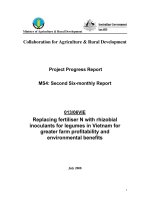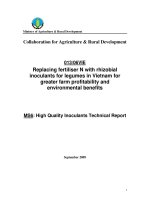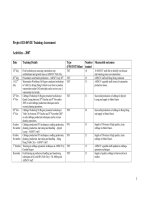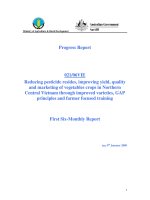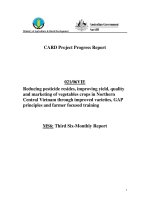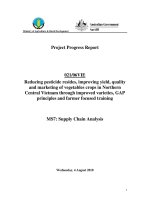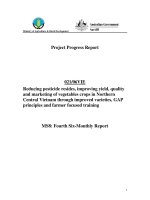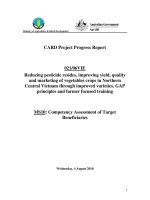Báo cáo khoa học nông nghiệp " Poor and forest-dependent communities in two communes in Cho Don District, Bac Kan Province are empowered to sustainable manage allocated forests and equitably share costs and benefits " pdf
Bạn đang xem bản rút gọn của tài liệu. Xem và tải ngay bản đầy đủ của tài liệu tại đây (81.06 KB, 4 trang )
1
Experiences from Project "Community Empowerment for
Forest Management (CEFM)"
By Nguyen Van Man
Thai Nguyen University of Agriculture and Forestry
1. Introduction of the Project
Project Title
: Community Empowerment for Forest Management - CEFM
Objective: Poor and forest-dependent communities in two communes in Cho Don
District, Bac Kan Province are empowered to sustainable manage allocated
forests and equitably share costs and benefits
Expected outputs of the Project
Output 1: Communities in Cho Don District, Bac Kan Province are implementing
sustainable participatory forest management
Output 2: Local authorities support community participation in forest management
planning, protection and land use management.
Output 3: A forest forum involving all related stakeholders in Cho Don established,
functional, and sustainable and benefiting the poor.
Output 4: A forest forum involving all related stakeholders in Cho Don established,
functional, sustainable and benefiting the poor.
Output 5: Lessons learnt documented and disseminated to other communes, districts
of Bac Kan Province
and national forestry forums
Location: Ban Thi and Xuan Lac Commune, Cho Đon District, Bac Kan Province
Duration: 2006 – 2009
2. Target group and forest resources at Project site
2.1. Target group
The target groups of the Project mainly are ethnic minority: Mong ethnic 40%,
Tay ethnic 24%, Dao ethnic 18%, Kinh ethnic 10%, Nùng ethnic 4% and Hoa ethnic
(Chinese) 4%. Among them, Mong people are recently moved from northern border
provinces to project site during year 1995 to year 1998 and most of them can not
speak Vietnamese.
2.2. Forest resources at project site
At the project site exit following forest and forest land types classified by
function and by owner:
2
- Production forest and forest land allocated to households: Mainly are
forests generated after slash and burn covered by generated trees, with low
volume and low economic value.
- Production forest and forest land managed by Commune People's
Committee: Mainly is bare land after slash and burn, far from villages and
is commune grazing area of the villages
- Protection forest allocated to households: Mainly are hill mountain forest
with tress of low quality, with low or average volume
- Protection forest managed by Commune People's Committee: Mainly is
rocky mountain forest, far away from villages, with average volume and
have some rare tree species, no or very little non-timber forest products
3. Experiences/outputs in forest management
3.1. For protection forest managed by Commune People's Committee
CEFM project associated with Local Project 661 to allocate forest to
community for protection and management. To do this, firstly CEFM project
supported villagers to establish forest management groups and developed the group
regulation and action plan, then local authorities approved the groups and group
regulation and action plan.
It is needed to attract the participation from all households in the village
during group establishing and the groups developed the benefit sharing mechanism it
shelves. During developing the group action plan need to prioritize the poor
households with little forest to participate in forest patrolling.
3.2. For production forest and forest land allocated to households
Project supported villagers to develop sustainable forest management plan. To
do this, firstly Project conducted the training, and then supported households to
develop their sustainable forest management plan. The sustainable forest management
plans developed for period of 7 to 10 years, based on the potential of the forest plot,
need and capacity of households. Households participating and caring out the
sustainable forest management plan are prioritized in seedling support than others. For
sharing experiences and supporting each other the group was established.
3.3. Organize the Forest Forum
The purpose of the forest forum is to create the environment for villagers,
cards, local authorities, stockholders, who interest in sustainable forest management to
exchange, share experiences and propose the ideas for developing forest development
projects.
During the project duration, forum at village level were organized in all
villages at project site, two forums at commune level and one forum at district level
were organized. The topics of the forums depend on the situation, but they are
problems concerned by communities and villagers.
3.4. Community capacity building in forest management
For community capacity building in forest management, Project focused on
following areas:
¾ Strengthening awareness on forest management focused on propaganda of the
roles and functions of the forest, the right and responsibilities of the forest
3
owner, the responsibilities of the authorities at all level on forest and forest
land.
¾ Establishing community organizations in forest management focused on
establishing forest management groups, sharing experience/interest groups,
and supported groups to develop the group regulation and action plan
¾ Improving technical knowledge on forest management focused on topics such
as planting and tending forest technique, forest patrolling skills, preventing
and fighting forest fire, developing household sustainable forest management
plan; study tour to successful sustainable forest management and development
models/projects, procedure and process of the forest planting design,
procedure and process of the forest product logging permission, nursery
technique.
¾ Besides knowledge related forest management, project also improved related
knowledge including agricultural technique such as planting hybrid corn,
making green manure, cultivating on slope land, planting sugarcane,…; and
improve community development skills such as facilitating skills, group
management skills, household economic management skills.
4. Difficulties for community forest development at project site
¾ Potential forest and forest land for community forest at project site mainly are
far from villages, located at commune or district border, difficult to patrol,
forest on the rocky mountain, no permission for cutting of timber trees, non
timber forest product limited, the remainder that is no protection forest is
mainly bare land and it is the common grazing areas of the villages, not attract
the in of the communities
¾ Almost households at project site were allocated quite big area of forest and
forest land varying 1 to 20 hectares, so they not much interested in community
forest
¾ Some present regulation not supported for allocation protection forest to
community, especially protection forest in the rocky mountain.
5. Experiences
¾ Capacity building for villagers and communities must be associated by
capacity building for local authorities
¾ To attract local authorities and organization to support communities in forest
protection and management.
¾ Increate the participation of the villagers in sustainable forest management
including decision making process through policy advocacy activities
¾ Decrease the pressure on the forest through income generation activities based
on forest and other income generation activities
¾ For the successful of the project need to closely associate between project and
local authorities, especially need to integrate the project activities in to local
social economic development plan and monitor by local authorities
¾ For the susses full of the trainings need to use field school method and use
local as interpreter for the village that can not speak Vietnamese
4
¾ Monitoring and evaluation of activities is needed
